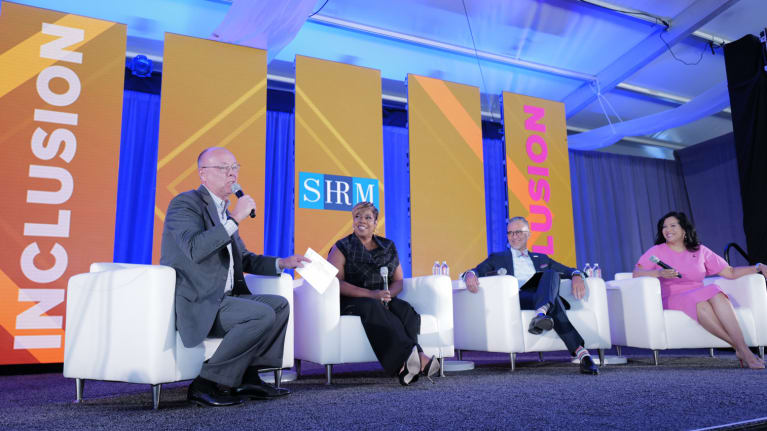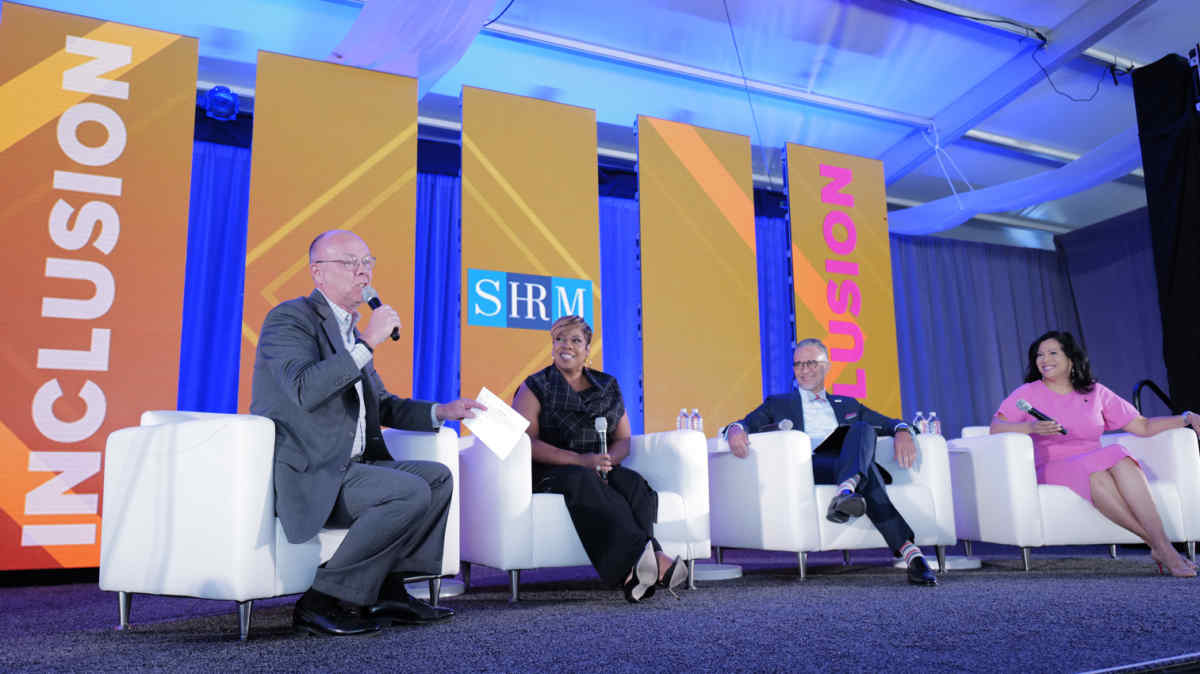

?A panel of diversity, equity and inclusion (DE&I) experts discussed the successes and failures of DE&I strategies on Oct. 25 during the SHRM INCLUSION 2022 conference in San Diego.
The session began with a discussion about effective DE&I strategies. LaQuenta Jacobs, chief diversity officer of transportation company XPO Logistics Inc. in Marietta, Ga., said it starts with simply talking about DE&I efforts.
“The increased focus on DE&I is something we’re doing right,” she said. “We’re also starting to elevate the voices in our orgs that haven’t been elevated before. We’re having more diverse convos.”
Pedro Jaime Torres-Díaz, office managing principal with Jackson Lewis P.C. in Miami, also commended companies for increased awareness around DE&I efforts, but he noted that true change cannot be made with the “top-down” model.
“Everybody needs to understand the importance and provide some input so the efforts are effective and successful,” he said.
Alicia
Petross, chief diversity officer of The Hershey Company in Hershey, Pa., said workplaces have been moving at a “locomotive pace” the last few years to improve DE&I.
“To be truly successful today, you need a large dose of co-creation,” Petross said. “Your CEO, board and senior leaders have to be committed. We need all of us. This work is about all of us.”
Where Companies Go Wrong
Jacobs said that building a healthy, diverse culture should be the goal of every company. Failing to support DE&I initiatives can have detrimental effects on an organization.
“As today’s headlines prove, an inclusive work environment is not just a nice-to-have, it can make or break a company,” Jacobs said.
But many organizations make mistakes in their approach to cultivating a sound DE&I initiative. These companies often:
- Lack buy-in from leadership. Successful programs start with support from the CEO. They can show this support through a clear business model that emphasizes DE&I and by routinely reiterating their objectives.
- Exhibit unclear goals. Many companies do not align their DE&I strategy with their key business imperatives. They should aim to achieve concise goals that all managers and employees can recite.
- Do not establish partnerships. Failing to seek stakeholder involvement can be detrimental for reaching DE&I goals. Organizations should identify their key stakeholders and ensure their DE&I goals align with their objectives.
Torres-Díaz said some organizations fail to listen to their employees and miss out on valuable perspectives that can enhance their DE&I strategies. As he said, “We have two ears and one mouth for a reason.”
“Listen to the different generations [in your workforce] and their perspectives,” he said. “Be empathetic and put yourself in their shoes to understand what they’re saying.”
Empathy is a critical characteristic of belonging, which helps create and sustain a thriving culture but often gets lost in the DE&I shuffle. According to the panelists, belonging:
- Is a fundamental human need. Companies must adapt their behaviors to minimize the lack of belonging in much the same way we try to avoid physical pain.
- Helps employees feel accepted. When belonging is intentionally fostered, workers can identify with one another and share a sense of purpose and a willingness to invest “emotional energy” to benefit the company.
- Excites employees. Belonging fosters a supportive and engaging place where people enjoy interacting with one another. It also helps to build a truly aware and inclusive culture.
“When I started my career, showing empathy was shown as a weakness,” said Jim Link, SHRM-SCP, CHRO for SHRM. “I like the now—it’s better than the old. It’s important for everyone to feel that sense of belonging and inclusion in the workplace.”
A Roadmap for Success
The panelists outlined several tips for sustaining a sound DE&I program:
- Capture quantitative and qualitative data to deeply understand the organization.
- Using assessment data, develop fully customized solutions tailored to fit the unique needs of the company.
- Implement the strategy and collaborate with the workforce to bring the DE&I strategy to life.
- Evaluate the effectiveness of the programs and measure impact.
Assessing the success of a DE&I strategy can involve assessing recruitment and retention statistics among workers of color, advancement opportunities among female workers, and employee perceptions of the company inclusion efforts.
“Break down the notion of DE&I into the smallest pieces possible,” said Torres-Díaz. “Can you sprinkle some DE&I in everything you do? If you embed that notion in everything you do, it will flow everywhere.”
Petross said that compensating managers for achieving success in DE&I has been “revolutionary” for her organization. She said that a company’s workforce will have more communication, clarity, ambition and forward movement when goals impact managers’ paychecks.
This strategy has helped eliminate the pay gap at The Hershey Company for salaried women and people of color, she said. By 2025, the company should reach global pay equity for all salaried employees.
“Be clear of what you want to accomplish,” Petross added. “Everyone has to start somewhere. Be aspirational and pragmatic.”

